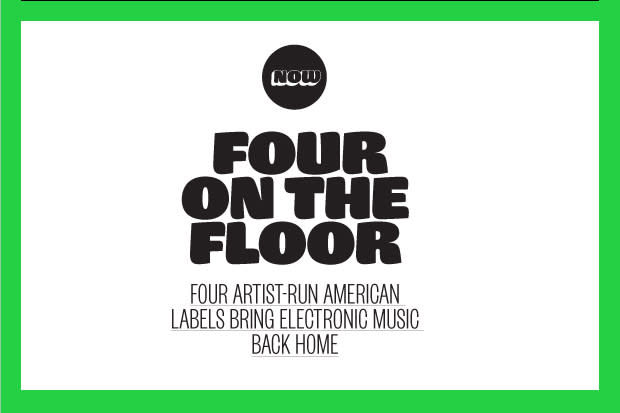 Everything goes in cycles, and right now we’re currently somewhere in the late-middle period of a heavy electronic music resurgence. Everyone involved is obsessed with talking about the textures of their music, and even more obsessed with acquiring vintage synthesizers to tool around with. We’ve gone to shows with stacked bills and seen not one guitar being used for an entire night. Much of this music has been coming from forward-thinking British artists, but there’s also a strong population of Americans making their own screwed up, personal versions of more traditional electronic music. The sounds of house and techno that began in Chicago and Detroit before migrating to the UK and to Germany are now returning home. Whether it’s through 100% Silk’s homemade approach to house, Software’s gorgeous drone, Fade to Mind’s epically dark dance jams or Future Times’ disco-obsessed crate diggers taking their music an extra step further than our minds can reasonably handle, electronic music is getting moodier, weirder, kinda freakish and a lot looser than ever before.
Everything goes in cycles, and right now we’re currently somewhere in the late-middle period of a heavy electronic music resurgence. Everyone involved is obsessed with talking about the textures of their music, and even more obsessed with acquiring vintage synthesizers to tool around with. We’ve gone to shows with stacked bills and seen not one guitar being used for an entire night. Much of this music has been coming from forward-thinking British artists, but there’s also a strong population of Americans making their own screwed up, personal versions of more traditional electronic music. The sounds of house and techno that began in Chicago and Detroit before migrating to the UK and to Germany are now returning home. Whether it’s through 100% Silk’s homemade approach to house, Software’s gorgeous drone, Fade to Mind’s epically dark dance jams or Future Times’ disco-obsessed crate diggers taking their music an extra step further than our minds can reasonably handle, electronic music is getting moodier, weirder, kinda freakish and a lot looser than ever before.

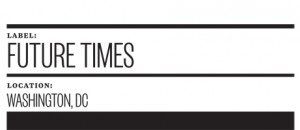 Andrew Field-Pickering lives in the same house he grew up in. It’s in Silver Spring, Maryland, a mostly quiet suburb outside of Washington, DC. His dad moved out, but his brother still lives there with him. His shelves are bursting at the seams with records. In the back of the house there’s an office/studio where Field-Pickering and his friend Mike Petillo operate their record label Future Times. There are some posters of gigs they’ve played on the wall, a couple keyboards, a computer and not much else. Future Times is obsessed with the complicated, unreliable history and minutiae of dance music, so it initially seems odd that the room in which they spend so much time thinking about music is so uncluttered. But then, Future Times is about making sense of dance music’s historical clutter—pulling brilliant ideas from bootleg recordings of undocumented warehouse parties and white label 12-inches smashed into dusty bargain bins.
Andrew Field-Pickering lives in the same house he grew up in. It’s in Silver Spring, Maryland, a mostly quiet suburb outside of Washington, DC. His dad moved out, but his brother still lives there with him. His shelves are bursting at the seams with records. In the back of the house there’s an office/studio where Field-Pickering and his friend Mike Petillo operate their record label Future Times. There are some posters of gigs they’ve played on the wall, a couple keyboards, a computer and not much else. Future Times is obsessed with the complicated, unreliable history and minutiae of dance music, so it initially seems odd that the room in which they spend so much time thinking about music is so uncluttered. But then, Future Times is about making sense of dance music’s historical clutter—pulling brilliant ideas from bootleg recordings of undocumented warehouse parties and white label 12-inches smashed into dusty bargain bins.
The label mostly releases music from their friends, but it is also home to Field-Pickering’s wonky solo project Maxmillion Dunbar and to Beautiful Swimmers, a group he formed with longtime friend, Ari Goldman. It also includes Mike Petillo’s band Protect-U, as well as whatever else they feel like releasing. All Future Times records are embedded with a deep, deep love of not just disco and house, but all electronic music. “There’s an intent,” Field-Pickering says of the label, “but I couldn’t tell you what that intent is, necessarily. There’s a sound that’s Future Times, but I don’t know how to tell you what that is off the top.” He and Petillo are knowledgeable about the material they’re influenced by, but not to a fault. Instead, everything they do is tinged by scrappy, homemade excitement. “We listen to house music at home,” Field-Pickering says. “It’s where you hear it. At 9AM, you wake up and you put on the most ferocious techno. That’s so tight. You can imagine yourself dancing to it in a club, but mostly you’re just finding out about it.” It’s like they already memorized the rulebook and are now on an endless quest to perfect their personal vision. “I think we’re the kind of people that are wired for music,” Petillo says. “That’s just what we’ve always needed to do as people to be happy. If you look at the people involved in this label, it’s people who have been—for most of their adult and adolescent lives—doing whatever music they can get their hands on.”
The idea behind Future Times is pretty simple: make and produce records for thosewho want to buy them. “You don’t need to feel like you’re latching onto the new coolest record that’s going to be the biggest hit,” Field-Pickering says. “What happens is, instead, you put out your own records that you love, and they become hits to certain people.” Petillo and Field-Pickering don’t have any kind of manifesto about changing dance music forever, but in their own way, they’re pushing it forward from within their self-contained crew. “Everything we’ve done, every second of every record has been something we’re totally into,” Petillo says. “We’re not in the business of putting stuff out just to have.” Each Future Times release has a surface-level accessibility. It’s not a completely alien sound, but it’s not exactly familiar either.
In addition to Future Times, Field-Pickering and Petillo, along with Goldman, host a monthly party, The Whale, at U Hall, a cavernous DC dance club. September’s edition is on a Wednesday night and the rain feels endless. The DJ booth runs the length of the entire back of the club, and it looms over the dance floor. Because it’s a weeknight, and because it’s dumping rain outside, half the people in the room could easily fit up there with them. Goldman and Petillo begin their set with whale noises that slowly get blended and modulated until they’re acting as vocals for the next song they play. It’s incredibly strange, but they make it fun to dance to. While they’re DJing, dudes amble through the gate to the booth, pulling records from crates and examining them like they fortuitously stumbled upon the most amazing garage sale, before going back to the floor to dance. And that’s the key. No one in the room is watching them DJ, really. Instead, they’re all dancing. When Petillo’s set is over, he’s on the dance floor, too.
Visiting Petillo’s Mt. Pleasant apartment the next day is like stepping into a mini version of Field-Pickering’s house, except it might have even more records. The pair hunch over a laptop, watching a video of two aging British dance nerds freaking out about a Roland TR-909 Drum Machine. It looks like they are sitting in a closet, fiddling with knobs and buttons while yelling out nonsense like, “Major European intelligent dance formation!” It’s funny, but more than that it’s embarrassing in the same way it’s embarrassing to overhear an elevator discussion about the finer points of Star Trek: Deep Space Nine. Petillo and Field-Pickering both think it’s hilarious. But as much as they’re laughing, it doesn’t feel mean spirited. It feels knowing, like they’re a part of it, too. By showing it to anyone else, they’re enthusiastically opening the door into their own special world. It feels good to be there.

Various Artists, Vibe 2 2x12-inch
A compilation of just about every Future Times contributor featuring stoney takes on weird house music stretched over two records.
Maxmillion Dunbar, Max Trax for World Peace 12-inch
Max D, aka Future Times’ Andrew Field-Pickering, loves nature sounds and cowbell. “Polo” sounds like a dance remix of the PeeWee’s Playhouse theme.
Protect-U, “World Music” 12-inch
Protect-U, the project of Future Times’ other half, Mike Petillo, is scrappy, homemade and jittery retro-futuristic drum machine disco.
Beautiful Swimmers, “Big Coast” 12-inch
Field-Pickering and Ari Goldman’s Beautiful Swimmers follows Future Times’ penchant for slightly off dance music and “Big Coast” is a gorgeous slice of digital dub.
SAM HOCKLEY-SMITH

 In August, 2009, Dan Lopatin compiled a kick-off compilation for his CD-R label Upstairs, titled Radio Scenic Glow Vol. 1. He called it “a bouquet of jams whose stems are entwined.” Lopatin sold the hand-marked discs for a year, before letting Upstairs go dormant. He insists it isn’t done, just on hiatus while he tends to Software, the new label he started with longtime collaborator Joel Ford in February 2011.
In August, 2009, Dan Lopatin compiled a kick-off compilation for his CD-R label Upstairs, titled Radio Scenic Glow Vol. 1. He called it “a bouquet of jams whose stems are entwined.” Lopatin sold the hand-marked discs for a year, before letting Upstairs go dormant. He insists it isn’t done, just on hiatus while he tends to Software, the new label he started with longtime collaborator Joel Ford in February 2011.
Like Upstairs, Software—an offshoot of Brooklyn’s Mexican Summer—is an experiment in electronic music with a mission to present a diverse array of sounds united by common tools and a vibe of comfortable weirdness. Following the success of That We Can Play, Ford and Lopatin’s 2010 EP recorded under the name Games, Mexican Summer founder Keith Abramson invited the duo to produce records in his studio, a music nerd’s idyllic playhouse hiding on a tree-canopied block in Greenpoint. They accepted.
Like archeologists and alchemists, Ford and Lopatin unearth historical artifacts, interpret them and then experiment with them. Explaining a new Software release they’re working on, Lopatin breaks down this pseudo-science. “It’s Laurel Halo playing piano, plus acid house, plus singing. It’s like the most inappropriate thing ever and it fucking works.” Then he compares another project to goo. Ford admits the duo’s 2011 computer funk LP Channel Pressure is an album people can dance to, but insists Software is not in the business of making party records, and Lopatin backs up that claim. “Electronic music has this rap of being really austere and far away from people. Or it’s practical, for dancing, cars or having sex. That confuses me because that’s not how I absorb it. Having a label, I want to raise up stuff that stimulates me and expose people to it. I hope there are other people like me.”
Ford and Lopatin found each other at middle school in Boston. They drew tape covers for dreamed-up bands, until Ford actually started a real band and wouldn’t let Lopatin join. “I just thought his technique was unprofessional,” he says. Both moved to Amherst, Massachusetts for college, Ford at UMass and Lopatin down the road at the freakier Hampshire College. Lopatin began recording alone, mounting what eventually became his solo project, Oneohtrix Point Never. Over time, OPN songs have become increasingly structured, but their gentle, ambient synths once sounded like an obsessive attempt to digitize the ocean’s crashing waves.
After school, Ford moved to New York to pursue his band Tigercity. Lopatin followed a girl to Boston, got a desk job, and kept recording, playing the results for Ford but few others. When the relationship ended, Lopatin moved to New York and started, at Ford’s nudging, to share his efforts. At a time when self-launching a career via Tumblr is maybe more feasible than finding success through a major label deal, self-trained bedroom producers with full stylistic control seem better off on their own. But Ford and Lopatin hated making music at home. “We made the Games EP in my bedroom,” Ford says, “and it was like, Let’s spend two hours setting shit up on my bed. And then an hour taking it down so I could sleep.” Now they’re able to jam for hours with no pressure, recording themselves and others in Mexican Summer’s studio, providing them with gear, time and an opportunity to refine their sound. “Working with other excited people keeps you engaged,” Lopatin says. “Software, for me, is a matter of growing up, like, I better work really fucking hard, because that’s actually a good way to live.”
Al Carlson, a cassette-obsessed stoner savant, is Software’s primary, in-house engineer. This year, he learned how to play a baffling 20-knob effect box called the Sherman Filterbank after tweaking with it for two weeks, three hours a day. That achievement’s not magic, but to Ford and Lopatin it might as well be. “Al’s just super passionate. We’re all really passionate about what we have here. You just get into, like, a meditative zone down there in that windowless space. There’s no internet. We’ve gotten so attached. We’re in love with that room,” Lopatin beams. The team worked 12-hour days during the Christmas season recording Channel Pressure. At one point, they got snowed in and locked down in sweatpants for 36 hours straight. When the blizzard ended, they’d arranged 30 songs.
But even the most obsessive need to air out sometimes. Ford is leaving New York, after almost seven years, to live with his girlfriend in North Carolina. “When you’re not on tour, it’s nice to not be in a bar, or a venue,” he says. But he has plans to come back, for as long as it takes, to help Software artists record. “It’s amazing to connect with those people and realize their days are like my days. Without having to even say much, there’s this like-mindedness. It’s a new kind of interaction for me, being with people who are excited and giving them the chance to share it. Pretty simple idea, but it feels good.”
Rescuing core elements like vintage synthesizers, filters, and samples from the internet and turning them into well-crafted sweeps and splats may feel straightforward to Ford, Lopatin and their growing family of musicians, but the resulting library will be good as gold.

Oneohtrix Point Never, Replica
Oneohtrix Point Never has always been about long, droning visions. Replica, his best work, is about bursts of ideas churning in congress.
Airbird, s/t 12-inch
Airbird is Joel Ford’s solo project and it has hippie vibes. Ultimately this is beat-based music, but it lives in a pretty, crystalline world.
Harmonizer, World Complete 12-inch
It’s easy to imagine Harmonizer as a duo of hip monks, silently studying texture. World Complete is spiritual white noise with handclaps.
Ford & Lopatin, Channel Pressure
Channel Pressure is Software’s funkiest release, slap-bass and a junk store’s worth of outdated synths. How this record came from two chin-stroking music geeks is anyone’s guess.
NAOMI ZEICHNER

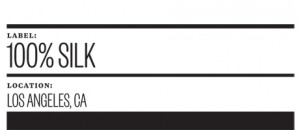 Sound the victory gong: Britt and Amanda Brown have finally reclaimed their living quarters. After years of running the gutsy underground label Not Not Fun out of their Eagle Rock apartment in Los Angeles, where inventory clogged the arteries and overtook space like some kind of vinyl kudzu, the husband and wife team have relocated to a house in nearby Highland Park that’s equipped with a proper office. The perimeter of their new dining room is neatly lined with shelves of records and cassettes from their personal, rather than business, stash. And when your home life and work life overlap as much as the Browns’ do, it’s psychically liberating to have spaces designated for each. Helpful, too, since in the past year, they’ve added a dance imprint, 100% Silk, to their already staggering workload.
Sound the victory gong: Britt and Amanda Brown have finally reclaimed their living quarters. After years of running the gutsy underground label Not Not Fun out of their Eagle Rock apartment in Los Angeles, where inventory clogged the arteries and overtook space like some kind of vinyl kudzu, the husband and wife team have relocated to a house in nearby Highland Park that’s equipped with a proper office. The perimeter of their new dining room is neatly lined with shelves of records and cassettes from their personal, rather than business, stash. And when your home life and work life overlap as much as the Browns’ do, it’s psychically liberating to have spaces designated for each. Helpful, too, since in the past year, they’ve added a dance imprint, 100% Silk, to their already staggering workload.
It is hideous but kind of tempting to describe the Browns as a power couple for LA’s eastside music scene, although the term implies a calculation and concern for coronation that’s totally at odds with their vibe in person: gregarious and thoughtful, with stabs of verbal flamboyance. Maybe a better way to put it is that their creative bona fides have earned them tastemaker status here: She co-founded Pocahaunted with Bethany Cosentino of Best Coast; he’s a vet of drone duo Robedoor; together, with Nick Malkin, they continue to spin webs of gothic psychedelia under the name LA Vampires. Being in bands is important, but since starting Not Not Fun seven years ago, the label stuff has become their true work.
The idea for 100% Silk came out of a desire to push that work even further. There was plenty of psych-rock, garage and noise floating around the NNF world, but Amanda became curious about stuff she loved that she wasn’t hearing much of: hip-hop, dance and R&B. “These are things that, for a long time, you could put out giant welcoming signs and you wouldn’t get those demos,” she says. “And as people are starting to listen to more electronic music over the past couple of years and have gotten more into beats, I thought the day was going to come when we were going to start seeing dance music, that we were going to start getting demos of people being forward-thinking and outside of that normal underground box.” To usher it in she tossed out the thought of launching a dance-specific offshoot of NNF. “I love all Amanda’s ideas, but I was just like, we’re already so busy with our own music and Not Not Fun that it seems like the last thing we need. But I’d also seen the same thing, that friends of ours have been evolving into different realms and working on things that were more overtly dancey. And right away I could see it was a good idea,” Britt says.
Since January 2011, Silk has averaged two 12-inches every other month (“I think staying active is the best press you could ever do for your label,” Britt says), starting with Ital’s Theme by Daniel Martin-McCormick bka Ital, and Muddy Tracks by The Deeep. Newer releases range from libidinous and bent Ace of Bassy stuff courtesy of London-by-way-of-Estonia’s Maria Minerva to the glamorous retro-futurist experiments of Pharaohs, but the unifying aesthetic, Amanda explains, is a kind of groovy decadence— total luxury material, as the name suggests. Interestingly, most Silk artists function as well a la carte as they do in the club. “A lot of the early Silk releases were supposed to ride that line of being influenced by dance music and culture, and not supposed to not function as that, but also sideways. I was saying the other day that a lot of the really good stuff to me sounds like krautrock: artsy and hypnotic,” says Britt, who, unlike his wife, did not grow up with any particular soft spot for the high BPMs.
The Browns aren’t sweating the heavy legacy of the dance genre, which includes a pair of obvious cautionary tales from decades past: how dance music’s moment of creative fertility can give way to joyless, old-guard purism; or alternately, how quickly the excitement and innovation of that moment can fade into some kind of cynical diffusion line at Urban Outfitters. “It’s partly the culture of gluttony in America,” says Amanda. “We turned it into rave culture so fast, and we turned ravers into these things no one wanted to be, and we consumed dance music so much that we actually made it gross for awhile.” But for whatever reason—the economy? The shitty political climate? The existential straitjacket we all seem to be wearing lately?—dance music is energizing again. “Sometimes it’s cool to stand still with your arms crossed and sometimes it’s cool to cut a rug,” Amanda says with a shrug. “I’d like to keep on putting out dance music for as long as people will have me, but if it stops being trendy I’m not going to stop enjoying it. It’s good. We could all stand some loosening up right about now.”

Ital, “Ital’s Theme” 12-inch
This is what happens when noise music gets some structure and goes pop. Ital takes harsh sounds and makes them into something worth dancing to.
Maria Minerva, “Noble Savage” 12-inch
Maria Minerva’s music is offbeat, unsettling and sometimes sounds like listening to a warped disco record while on acid.
Innergaze, “We Are Strange Loops” 12-inch
Super damaged music that could soundtrack a dance party that had Blade Runner on constant loop from a projector.
Magic Touch, “I Can Feel the Heat” 12-inch
Initially, Magic Touch feels like normal house music. But the more you listen, the more it feels like an outsider’s take on insider music.
CAROLINE MCCLOSKEY
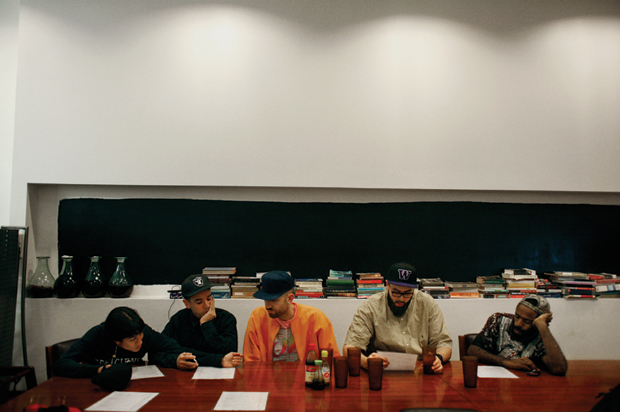
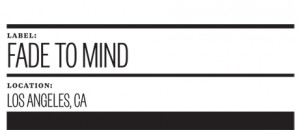 As the empirical wisdom of grandmothers, behavioral therapists and eHarmony’s marketing brigade has taught us, having common interests is crucial to establishing successful and fulfilling long-term partnerships. Doubtless they’re referring to a shared passion for doubles tennis and Ansel Adams landscapes, but the common concerns for the principals behind LA-based label Fade to Mind—bass, art, nature, Baltimore club, UK grime and garage, computer experiments—are equally strong glue, and suggest the collective is in it for the long haul. And for those who like to get whipped into states of ecstatic, primordial bliss on the dancefloor, this is very exciting news.
As the empirical wisdom of grandmothers, behavioral therapists and eHarmony’s marketing brigade has taught us, having common interests is crucial to establishing successful and fulfilling long-term partnerships. Doubtless they’re referring to a shared passion for doubles tennis and Ansel Adams landscapes, but the common concerns for the principals behind LA-based label Fade to Mind—bass, art, nature, Baltimore club, UK grime and garage, computer experiments—are equally strong glue, and suggest the collective is in it for the long haul. And for those who like to get whipped into states of ecstatic, primordial bliss on the dancefloor, this is very exciting news.
Primary credit is due to Ezra Rubin for turning on his transponder early to gather his people. Back in 2005, after attending Parsons, he and his friends decided to throw a dance party inspired by insane mixes— Dipset, Cam’ron, Remy Ma—then in rotation on Hot 97. Since no one knew how to DJ, they’d burn CDs and play them in the back of a liquor store in Williamsburg. The clothing designer Telfar was a patron and taught him how to use CDJs, and soon Rubin began blending, eventually turning out an hour-long mixtape that sold at Opening Ceremony in New York. Under the name Kingdom, he began releasing music on Fool’s Gold and the influential UK label Night Slugs, whose homegrown creative collaborations and consistent packaging became an inspiring model for Fade to Mind.
Rubin’s future labelmates were located via methods both analog and digital: he connected Ashland Mines (Total Freedom), then based in Chicago, through mutual friends; Mines’ Myspace page led him to production whiz kids Nguzunguzu. “I didn’t even know what they looked like—their only picture was this faraway shot of them lying in the grass,” remembers Rubin. “They were just on this different vibe, there was clearly an R&B influence, but also this experimental noise influence. And they sent me this CD-R, they just burned it and spray painted it black, and it was almost bent from the spray paint, in some weird paper sleeve, and tracks from that I ended up editing and making remixes of. From that point, I started to work with them.”
By 2010, Kingdom, Total Freedom and Nguzunguzu had all relocated to LA and began to collaborate for real, playing parties together and remixing each other’s work in ways that felt fresh and energizing. “I think we all came from a perspective of thinking about sound and music, not just, I’m gonna play a bangin party and it’s gonna be hot, but more, What’s the emotional resonance of the sounds that we pick?” says Rubin. “We were influencing each other from the start, pulling and pushing each other into the same emotional sphere, club music that’s a little sad, sexy and scary.” They were all busy releasing on different labels, and the thought of branding their scene hadn’t crossed anyone’s mind. But when friend and DJ Will Boston (aka Prince William, now a Fade to Mind co-runner) encouraged him to formalize their work with a label, Rubin could see the benefits: creating a consistent aesthetic, giving people something definite to latch onto, solidifying it into a movement. The label’s name is a reference to both the barbershop fades Boston and Rubin are obsessed with and the state of mind FTM hopes to induce in listeners. “I think good music makes you fade into a subconscious zone, or when you smoke weed you fade to mind, or when you have sex—just those kinds of experiences that take you into a deeper mind state,” says Rubin. Their first release, Nguzunguzu’s Timesup EP, was a group effort right down to the artwork.
Like their allies on Night Slugs, Fade to Mind is pushing aside dance music’s dusty reputation as a closed, traditionally male-dominated UK-centric relic of the ’90s and invigorating the scene with young talent from around the globe. You might recognize some upcoming FTM artists from their cameos on Kingdom mixtapes past: underground vogue/ballroom innovator MikeQ; leftfield, juke-influenced Finnish producer Gremino; and Cedaa, an uptempo crunk DJ from Bellingham, Washington. Asma Maroof from Nguzunguzu can expect to be joined by more female labelmates in the future, too. “I’m super excited to have as many female producers as possible on the roster,” says Rubin.
After years of being bummed by lackluster turnouts and frustrated by the disjointed nature of playing mercenary sets among a lineup of strangers, Rubin is excited that dance music is finally having another moment. The cohesive feeling created by Fade to Mind artists is gaining momentum, and it’s clear there’s power in alliance. “When the whole night is filled with this universe we’ve created, even the broader collective, which is really Night Slugs people and Fade to Mind people together, I notice the energy of the nights is much bigger,” he says. “People don’t necessarily want to see just one of us, they want to be entrenched in it.”

Nguzunguzu, Timesup
Nguzunguzu are strange, wonderful DJs. Timesup harnesses a leftfield dance infatuation into their own sublime production.
MikeQ, “Let it All Out” 12-inch
MikeQ’s “Let it All Out” is readymade for vogue balls. It touches on vocal house, Baltimore club and is the ultimate melting pot for dance floors.
Various Artists, The Claw
The Claw is Fade to Mind’s thesis statement, a limited CD-R with all of their artists contributing tracks. This is the type of thing ethnomusicologists make after the fact.
Cedaa, TBD
Cedaa, a very young producer from the Pacific Northwest, produces drums wound so tight his songs feel like practice for insane future trilling.
CAROLINE MCCLOSKEY
